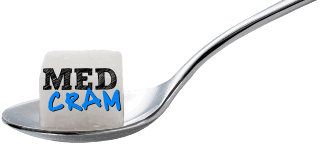In this latest video from MedCram, Dr. Seheult discusses what CPR is? In the hospital, patients are typically asked if they want to have “everything done” to keep them alive when the physician is going over a code status. The question is are the risks of CPR worthwhile? There are many misconceptions about what CPR is and what it can and can’t do. There have been articles written that do discuss this such as the one written by Clay Dalton that discusses the perspective that a “natural death” may be preferable for many than enduring CPR.
What is CPR?
Many know that CPR stands for cardiopulmonary resuscitation. It originally started back in 1960 when an article published in JAMA talked about CPR. Prior to this the standard practice had been open thoracotomy and direct cardiac massage. It was about this time that the idea of external transthoracic cardiac massage developed after much experimentation on animals. The survival rate they noted was 70% at that time.
The heart itself is surrounded by the rib cage. Chest compressions are done at a depth of 2 to 2.25 inches and need to be done at a rate of 100-120/min to be most effective. Ideally it is best to switch the compressor (the person doing CPR) every 2 minutes as CPR is physically demanding. A popular song that is used now to keep this tempo up is the BeeGees “Staying Alive.”
What does the general public think of CPR?
The general public from the a literature study found that most of the public’s opinion is based on what is depicted on popular TV shows. The Hollywood version of CPR shows that it is usually a survivable and beneficial procedure and if this is the case, then why wouldn’t every person want CPR done? When this study asked surrogate decision makers of ICU patients what CPR means, they found that 72% (the majority) believed that survival after CPR was greater than 75%.
What are the actual numbers regarding CPR survival?
The actual results from CPR are far more dismal. This study did a meta-analysis and found that the pooled survival rate of persons with out-of-hospital cardiac arrest to hospital admissions was only 23.8% and to hospital discharge was only 7.6%. What improved chances of making it to discharge? If the out of hospital cardiac arrest was witnessed by a bystander it raised the survival from 6.4% to 13.5%, if it was witnessed by an EMS it raised the survival from 4.9% to 18.2% and if found in ventricular fibrillation/ventricular tachycardia it raised it from 14.8 to 23%, if a bystander was doing CPR it raised it from 3.9% to 16.1% and if return of spontaneous circulation was achieved, it went from 15.5% to 33%.
Does CPR help the brain?
For in hospital cardiac arrest, this study showed that from 2000 to 2009, the risk-adjusted rates of survival to discharge increased from 13.7% to 22.3% and they found that the rates of clinically significant neurologic disability among survivors decreased over time, with a risk adjusted rate of 32.9% in 2000 and 28.1% in 2009.
So even if a person survives a cardiac arrest, almost a third of survivors will have a clinically significant neurologic disability because during the cardiac arrest the brain may not be getting enough blood supply even with CPR being done. This study discusses long term outcomes after in-hospital CPR in older adults with chronic illness. It found that patients with chronic diseases will have decreased survival overtime.
What are complications of CPR?
What are the complications of CPR? These include broken ribs, pneumothorax (collapsed lung), pulmonary hemorrhage (bleeding in the lung) and a patient may even regain consciousness during the time CPR is occurring as blood flow is restored and actually be “awake” while CPR is occurring.
One thing Dr. Seheult comments that he has learned with CPR is that often ribs will break and those jagged edges can go into the lungs and cause a pneumothorax (collapse of the lung). So he likes to use lung ultrasound at bedside to evaluate this as waiting for symptoms to develop or waiting on a chest x-ray may take too much time. Ultrasound can be used to help identify a pneumothorax earlier. MedCram does have an ultrasound course to help explain this further. If there is a pneumothorax present, then a chest tube needs to be placed.
So what is CPR really?
Going back to the original article by Clay Dalton, the reality is that the purpose of CPR is to bridge a person to some type of intervention. If that intervention isn’t available or doesn’t exist, then what is CPR actually accomplishing? It must be remembered that CPR does not remove the underlying cause that led to the cardiac arrest in the first place. What needs to happen is a detailed discussion as to what a Full code vs DNR code status is. MedCram has a video on this to help practitioners with these patient discussions.
LINKS / REFERENCES:
For many, a ‘natural death’ may be preferable to enduring CPR (NPR) | https://www.npr.org/sections/health-s…
CLOSED-CHEST CARDIAC MASSAGE (JAMA) | https://jamanetwork.com/journals/jama…
It isn’t like this on TV: Revisiting CPR survival rates depicted on popular TV shows (Resuscitation) | https://pubmed.ncbi.nlm.nih.gov/26296…
What CPR means to surrogate decision makers of ICU patients (Resuscitation) | https://pubmed.ncbi.nlm.nih.gov/25711…
Predictors of survival from out-of-hospital cardiac arrest: a systematic review and meta-analysis (Cardiovascular quality and outcomes) | https://pubmed.ncbi.nlm.nih.gov/20123…
Trends in Survival after In-Hospital Cardiac Arrest (NEJM) | https://www.nejm.org/doi/full/10.1056…
Long-term outcomes after in-hospital CPR in older adults with chronic illness (Chest) | https://pubmed.ncbi.nlm.nih.gov/25086…
DNR Code Status Explained Clearly (MedCram) | • DNR Code Status Explained Clearly
Ultrasound Courses (MedCram) | https://www.medcram.com/collections/u…
